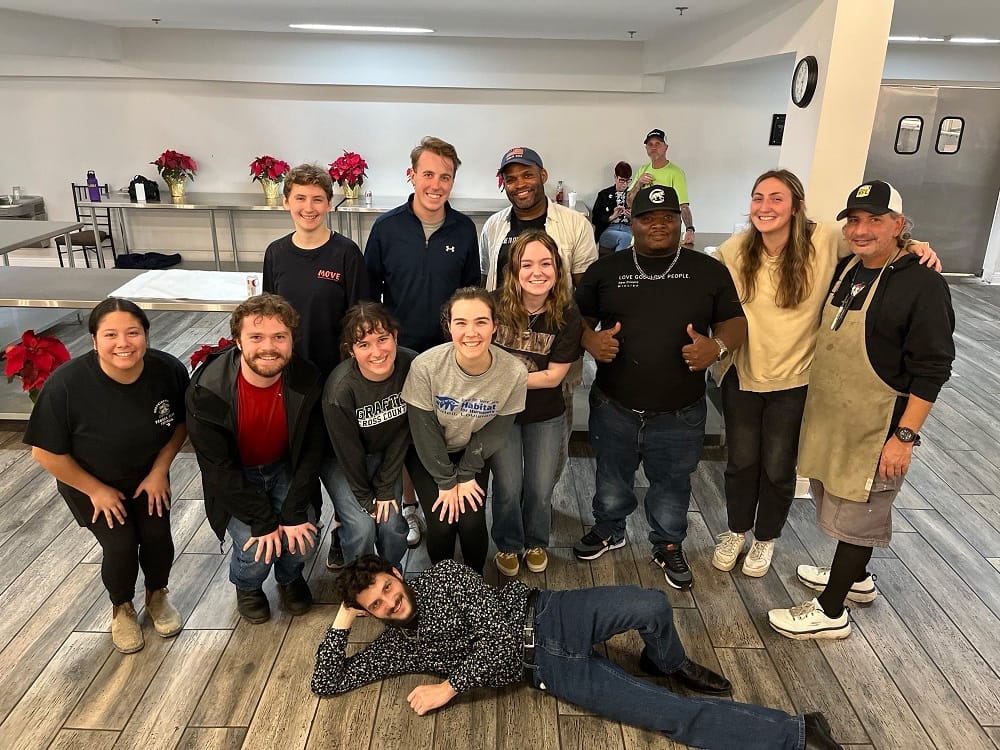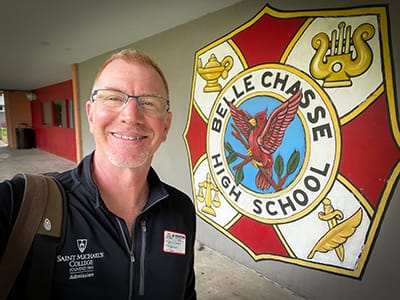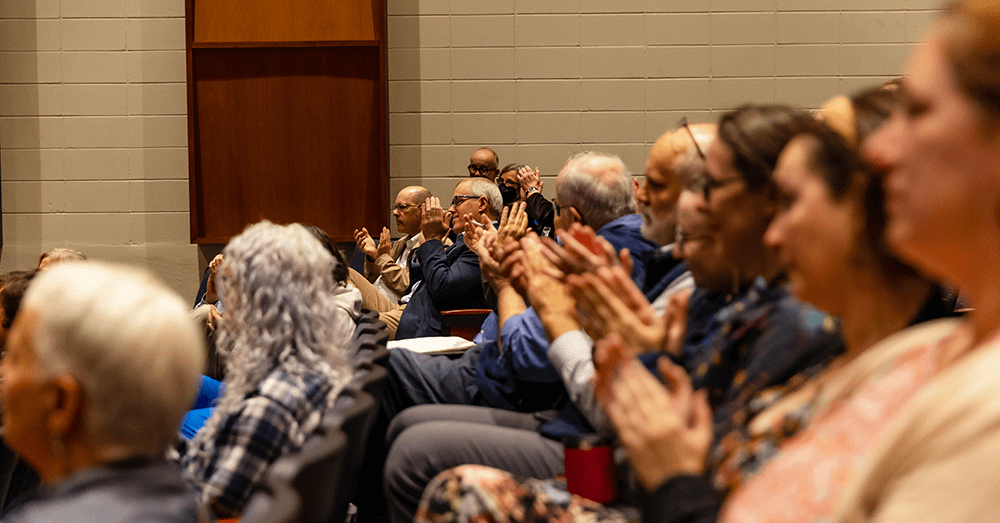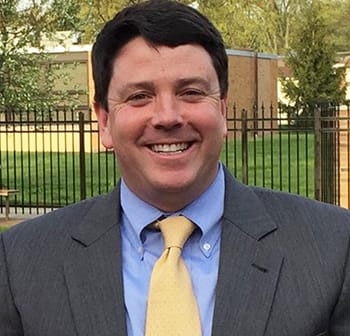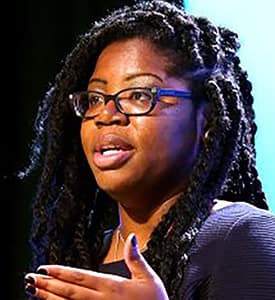Solar eclipse illuminates the wonder of Saint Michael’s
View a photo gallery of the solar-eclipse viewing on campus>>
It was something to see: a rare partial solar eclipse as experienced by nearly 100 upbeat and excited Saint Michael’s people around physics Professor Alain Brizard’s small telescope set up alongside the large clock on the main campus green Tuesday afternoon.
It also was something to hear:
“Whoaaaah!” …. “Oh my God, that’s really cool!” … “Ahhhhh! Wow…. This is amazing!” … “That’s crazy — you can really see it!” called out different voices in rapid succession from an assembly that steadily had grown for an hour and a half until the eclipse peak at 2:40 p.m. when the moon covered 68 percent of the sun, as viewed from this Vermont location.
Many of the exclamations were from folks taking turns donning special glasses for safely viewing the eclipse, which they had brought with them to the pretty bench-and-flower enclosed paved circle in the middle of the central large lawn, in view of the major campus buildings on a perfect sunny August afternoon.
Brizard of the College’s physics faculty also had brought out his 40-year-old, personal 3.5-inch Questar telescope and set it up on a table at the site shortly after 1 p.m., when only a smattering of folks took turns looking in the eyepiece, just as the moon first started to visibly move over the sun.
Those included the children of Ruth Fabian-Fine from the biology faculty – her 12-year-old son Elliot, wearing a Boston Science Museum T-shirt with the words “Come to the dork side,” had made an eclipse-viewer out of a box of cereal, tinfoil and white paper. “It’s like a projector and then I can look at the eclipse” he demonstrated as his brother, Nathaniel, 11, looked on.
Brizard explained to early arrivals how he was using a partially reflecting mirror that lets in just about 1 percent of the sunlight, making it possible to view the eclipse. Earlier by email, the Princeton-educated professor (who besides his astronomy interest is a worldwide authority on nuclear fusion) had invited the campus community to join him.
Acting as unofficial host and ringmaster, Brizard regularly recalibrated his instrument, talking animatedly about science with children and grown-ups. “It’s the perfect size for viewing an eclipse,” he said of the telescope as he helped the steadily growing crowd peek through the viewfinder if they cared to. By 2:30 p.m. there was a line.
Besides the special glasses, several people, young and old, brought devices to more creatively experience the eclipse in novel ways – such as a colander that Dean Jeffrey Trumbower brought to “project” the image of the eclipse image on paper placed on the pavement.
Along with the dean, President Jack Neuhauser and a group from his office stopped by as did Karen Talentino, vice president for academic affairs, other administrators and a majority of science faculty members from nearby Cheray Science Hall. In the mix, too, were large groups from the Admission and Institutional Advancement offices, several campus safety officers, international students (including one man from China who stayed the whole time), student orientation leaders who were on campus early to prepare for Thursday’s new arrivals, and even Deacon Michael Carter of the resident Edmundite community, whose ordination to the priesthood will be in a few weeks. He chuckled at joking that eclipses and priestly ordinations are similarly profound and highly anticipated.
Brizard seemed tickled as his impromptu viewing became an extended festival of excitement, wonder, inquiry and warm good will to set what felt like the perfect tone before first-year students arrive later in the week.
“We are really so small in the world, you know that?” said Kellie Campbell of the Instructional Technology and Accelerated Summer College staff and she gazed skyward through eclipse glasses.
“Who ever said science is boring?!” exclaimed Brizard as the peak eclipse moment was nearing and the buzzing crowd grew.
Mark Lubkowitz of the biology faculty, who brought his young son for the occasion, remarked that with all the excitement, “It’s almost as good a ‘Y2K’ in that you know it’s not going to be apocalyptic – but you’re just not 100 percent sure it’s not going to be apocalyptic.” Answered Brizard, “There’s a big difference – this is real!”
John Payne, the College’s library director, said he had recently emailed any students from a class he taught last year on medieval science. “We learned in the class about how, in the 600s in Visigothic Spain, people panicked during an eclipse, and the King of the Visigoths asked Isidore of Seville to write a science textbook to give to all the priests, so if it were to happen again, the priests could explain it to the people,” Payne explained. “So I wrote to my students, ‘Remember what Isidore taught you – don’t freak out! A dragon isn’t eating the sun, and everything’s going to be fine!’”
VPAA Talentino, waiting in the line to look through Brizard’s telescope, said after that the whole affair reminded her “how fortunate we are to have jobs with an institution that is committed to education. It was a joy to share the eclipse viewing with such a wide variety of our Saint Michael’s community today.”
“To see everyone excited about a natural phenomenon, and to hear so many questions and comments of wonder and excitement from children, students, staff and faculty, reminded me of why I became an educator, and specifically a science educator,” Talentino said. “Thank you to Alain Brizard for initiating such a fun learning experience.”
